As one of the world leaders in LCD technology, it’s not surprising that Samsung’s range of LCD TVs contains an intimidating number of models. The company has so many flat screen televisions, sometimes with only small variations, that it can be difficult to keep track of, let alone choose between them.
<!-- google_ad_client = 'pub-2887677957235196'; google_ad_slot = '4990177225'; google_ad_width = 336; google_ad_height = 280; //-->
The Samsung LE40A786 is special, however, as it features LED backlighting technology instead of the conventional CCFL fluorescent lamps. This means that this HDTV can produce a considerably superior contrast ratio. Whilst conventional LCD televisions have an array of backlight lamps which are constantly turned on behind the screen, the A786 series TVs feature clusters of smaller LEDs instead, which can be independently controlled. For a real world example, imagine a scene of a pitch black sky, with a full moon in the middle. A conventional LCD TV would have to light up the entire screen consistently, but an LED-backlit LCD display can dim the areas featuring the black sky, whilst keeping the approximate area surrounding the moon lit up.
It’s an exciting proposition, which really means that the Samsung LE40A786 should be able to give us whiter whites and blacker blacks. Let’s find out how it performs!
Update 2 May 2009: The LE40A786 is slowly being phased out, and has been replaced by the Samsung UE40B7020WW which uses an Edge LED backlighting system as opposed to the local-dimming version implemented on the A786.
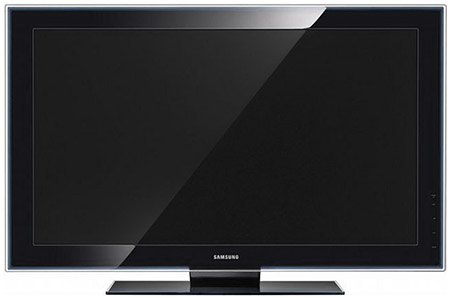
Aesthetically, the Samsung LE40A786 HDTV at first appears to be nothing special. It features Samsung’s “Crystal Design”, but for over a week, we thought that it lacked the killer “Touch of Colour” design feature around the edges of the bezel. Only when we accidentally shone a light around the display did we notice that there actually is a barely visible blue tinge! It’s a shame this just isn’t a little more prominent, because it looks great when you can actually see it.
The thickness of the bezel might make the viewing area seem a little smaller if you’re used to the “Picture Frame” style LCDs being increasingly pushed by Toshiba and Sony, but on the whole, we don’t have any major complaints regarding the appearance of Samsung LE40A786.
Also, the touch panel is worth noting. To the bottom right of the screen is a series of vertically stacked blue lights, which illuminate the various pressure-sensitive buttons. These appear when you turn the Samsung LE40A786 on, and disappear shortly afterwards.
Connectivity is getting harder and harder to write about when it comes to HDTVs, purely because there are really no surprises anymore. Along with the usual SCART, VGA, Composite, S-Video, Component and RF connections, it’s notable that this display features no less than four HDMI inputs (one of which is on a recessed side panel).
No surprises here… the Samsung LE40A786 might feature the latest backlighting technology, but its menus are the same old – they’re not especially attractive, but they’re easy to navigate and better yet, they’re fast.
One unusual thing we noticed with these menus is that there is, in fact, a teeny-tiny amount of colour bleed visible when an option is highlighted in orange. This is very unusual, because flat panel TVs typically draw the on-screen menus at the very end of the display chain, before such quirks can occur. We noted this and decided to check later to see if any colour bleed was present in situations where it might actually matter (on actual content).
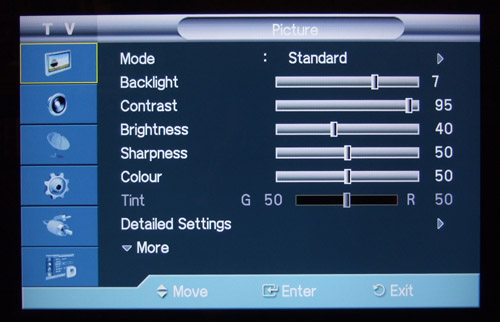
As usual, Samsung’s top-level picture adjustment is the [Mode] setting. This can be set to either [Dynamic], [Standard] or [Movie]. We selected [Movie], which immediately presented a considerably more watchable picture. As well as the typical basic calibration settings, there’s an adjustment for the overall [Backlight] intensity.
Moving on to [Detailed Settings], there’s a host of tweaks, the important ones being a very basic [Gamma] adjustment, a [Colour Space] setting which allows for some colour management, and last but certainly not least, a [White Balance] adjustment. Many manufacturers hide this setting deep within the engineer’s menu, so we’re absolutely delighted, as usual, to see Samsung present it in a user-accessible menu.
The tweaks don’t end there. There’s also [Picture Options], which allows selection of a [Colour Tone] (to switch between greyscale presets), [Size] and [Screen Mode] to control the aspect ratio, and [Digital NR] to apply a temporal blur to slightly reduce moving image noise. There’s also control over [100Hz Motion Plus], a [Blue Only Mode] to aid colour fine-tuning, and last but certainly not least, the [Smart LED] option, which allows you to turn the regional dimming feature on or off (useful for demonstrating the advantages of the LED backlighting technology). Oddly, turning this on or off would take us out of the “Movie” picture mode and send us back to the wacky-looking “Dynamic”, but this was easily corrected.
Again, the Samsung LE40A786 uses the same old Samsung EPG. It responds quickly to key presses, and shows all the information you could want to see. Pressing the middle navigation button sets a reminder for a programme, and pressing the Channel Up and Down keys jumps up and down a page of channels.
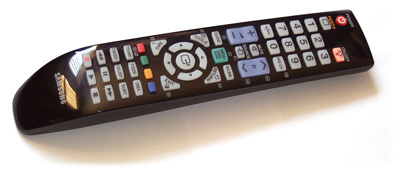
Once again, we have a sense of deja vu… if it ain’t broke, don’t fix it. Samsung’s remote, although being styled in the fingerprint-catching gloss black, features clearly labelled buttons which are logically placed and depress nicely. Better still, there’s a backlighting feature too, so you can use the remote in a darkened room.
We used the [Movie] and [Warm2] options as a starting point for calibration. These produced the following results:
 |
| [Colour Balance] “Warm2” CCT |
 |
| [Colour Balance] “Warm2” RGB tracking |
There’s a visible emphasis of both red and blue at different points, producing a colour temperature which manages to be both too high and too low at times. Why settle for this when Samsung provides such easily accessible Greyscale adjustments? Using these, we were able to bring things much closer to spec:
 |
| CCT after greyscale calibration in “Movie” [Picture Mode] |
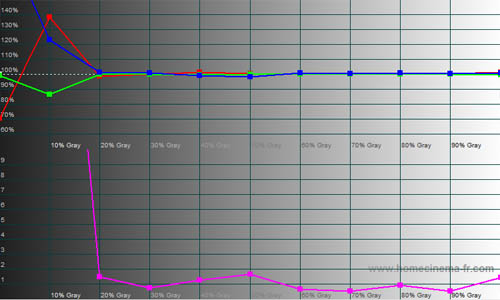 |
| RGB tracking and delta errors (dEs) after greyscale calibration |
We were extremely pleased with the results of this calibration. The irregularities at the lower end of the chart (left) result from the extreme levels of darkness provided by the LED-assisted display causing problems for our sensor, so feel free to ignore these.
As you can see from the pink line at the bottom of the RGB tracking chart, delta errors never rose above around 1.7, meaning slight inaccuracies in our calibrated example should be all but unnoticeable. It’s fantastic that Samsung provide this adjustment option in their user menus, and we wish all manufacturers took this initiative.
![Pre-calibration CIE [Auto]](https://www.hdtvtest.co.uk/news/wp-content/uploads/2018/04/hdtv_Samsung-LE40A786_cie_auto.jpg) | ![Pre-calibration CIE [Native]](https://www.hdtvtest.co.uk/news/wp-content/uploads/2018/04/hdtv_Samsung-LE40A786_cie_native.jpg) |
| Pre-calibration CIE [Auto] | Pre-calibration CIE [Native] |
Out of the box, Samsung provides a colour space called [Auto], which, as evidenced by the CIE chart, undersaturates colours somewhat. The [Native] mode appears to ramps colours up as high as the panel will allow, making things oversaturated instead. Finally, Samsung provide a [Custom] mode which allows the mix of Red, Green and Blue making up all six primary and secondary colours to be controlled. Using this feature, we were able to, once again, bring things very close to the desired Rec.709 HDTV standard:
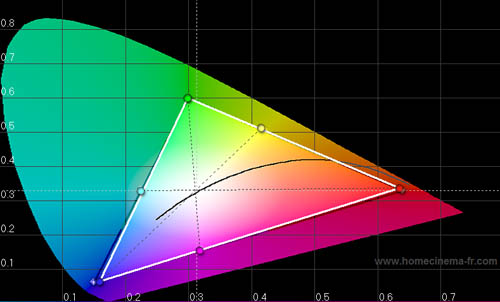 |
| CIE chart with reference to HD Rec. 709 after calibration with HD source |
Red and blue were a little hard to configure exactly, but both were still relatively close to the desired targets. The slight error in blue will probably be undetectable in real world situations.
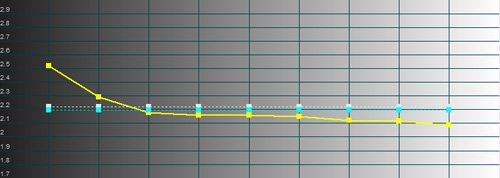 |
| [Movie] mode with Gamma +1 |
Although none of the Gamma adjustments in the TV’s menu gave a completely flat line, setting Gamma to +1 gave the closest average match to a gamma of 2.2 (indicated by the blue line). Raising or lowering the Gamma option essentially only raised or lowered the yellow line.
| Dead pixels | 2, one dead pixel, one stuck green pixel |
| Screen uniformity | Some clouding visible off-angle, [Smart LED] mode and calibration help make this negligible |
| Overscanning on HDMI | 0% with [Display Area] set to “Full Pixel“ |
| Blacker than black | Passed |
| Black level | True black (0 cd/m2) possible with [Smart LED] on |
| Black level retention | Fluctuates if [Smart LED] on |
| Primary chromaticity | Excellent with [Colour Space] “Custom” tweaked |
| Scaling | Average |
| Video mode deinterlacing | Average; some jaggies reduction |
| Film mode deinterlacing | Good; passed the most common cadences (2-2 PAL and 3-2 NTSC) |
| Viewing angle | Horizontal good for an LCD TV (90°), black washout evident at Vertical angles |
| Motion resolution | 600 with [100hz Motion Plus] on Low, 250-300 off |
| Digital noise reduction | Acceptable at baseline |
| Sharpness | Defeatable edge enhancement |
| 1080p/24 capability (PS3) | Accepts 1080p/24 video signal; no telecine judder; but see notes on combing |
| Input lag | 30-70ms, depending on configuration; see dedicated section |
| Default | 192 watts |
| Calibrated | 132 watts |
| Standby | 3 watts |
And now, we get down to business. With the [Smart LED] option enabled, the Samsung LE40A786 struts its stuff and, unsurprisingly, shuts off LEDs as necessary. As a result, a completely black screen measures an unbeatable (literally!) 0 cd/m2 (yes, 0: nil, none, nada).
On its own, though, this is a little easy. We already knew that LED TVs can turn areas of the screen completely off. More appropriately, we fed an ANSI test pattern to the Samsung LE40A786 HDTV. This pattern features alternating black and white boxes in a chessboard-like structure. Due to the approximate nature of the LED backlighting, there was a very small amount of visible glowing around the white areas, which is to be expected, as the dimming is not controlled with per-pixel accuracy. The severity of the glow depended on the viewing angle, but was minimal in the most common positions. From higher angles, the glowing was a little distracting. That’s not really a problem, because a television will typically be placed at eye level, and we doubt this will raise its head in real world situations.
Over HDMI, and with the [Full Pixel] mode turned on, the Samsung LE40A786 successfully resolved each nuance of the horizontal and vertical 1920×1080 line patterns.
However, colour resolution took a very slight hit due to the aforementioned Y/C delay problem (“Y/C delay” being where the colour component(s) of a picture appear slightly out of horizontal alignment with the brightness component). In almost all cases, photo-realistic content and viewing distances should make the effects of the error unnoticeable, but colourful computer generated content or animation, and a pair of sharp eyes, can reveal it.
Using the FPD Benchmark Software Blu-ray Disc, we were able to determine that the Samsung LE40A786 can muster around 600 lines of motion resolution with the [100hz Motion Plus] mode on its [Low] setting. We recommend using on the [Low] setting; as the [Medium] or [High] settings will not increase the motion resolution, but will increase the amount of motion interpolation applied. [Low] gives us the benefits of 100hz but with a minimum of the distracting interpolation effect. This setup is completely suitable for most video programming, and should please sports fans.
Film users, however, might want to leave the system turned off, for a more cinematic look. As the 24fps (or 25fps for a 50hz source) rate of a film is not particularly high, LCD panel blur should not be a huge issue. In this case, losing the 100hz system (and its associated look) should be an overall improvement.
The input lag on this display is typically around 50-70ms. This is unusually high, and with a PC connected, you can feel the drop in speed as you drag a window around on the TV screen.
However, this can be improved a little, with some conditions. In the TV’s [Input] menu, labelling the HDMI input as “PC” (using the [Edit Name] function) will disable certain picture processing circuits and drop the level of lag to a more tolerable 30-40ms. As a result of bypassing certain circuits, some options in the Picture menu will be greyed out. Sadly, one of these is the [Smart LED] option, which is, presumably, a major selling point of this display since it holds the keys to the regional dimming option. And, the level of lag is still higher than several other displays on the market.
Additionally, there’s an [Entertainment Mode] setting called “Game” which also drop the level of lag to around 30ms, but as this forces unrealistically high brightness and sharpness settings (amongst others) on the viewer with no chance to alter them, it is effectively useless.
The LE40A786’s video processing is average. The diagonal interpolation (video jaggies reduction) is somewhat effective, although we’ve seen better. And, it correctly detects both 2-2 (PAL) and 3-2 (NTSC) film cadences. Scaling was rather blurry and undefined. We expect most people will have their own Upscaling DVD player to make all of these points moot, however.
Video Processing is probably the section where we should note an unusual problem with the Samsung LE40A786. Irritatingly, with any source except a 60hz input, combing would appear every so often, even with a fully Progressive source. We can only assume that this display routes these signals through a 1080i video processing circuit, which is unusual. Keep in mind that as the combing is at 1080i resolution, the misplaced lines are only one pixel high and may be unnoticeable at certain viewing distances. Nevertheless, the issue is here and is especially significant in the UK, where there is an abundance of affected 50hz video content.
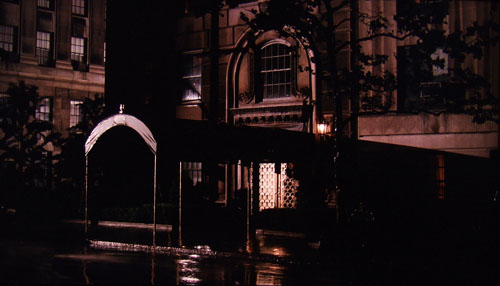
Using the stunningly filmic Blu-ray Disc of The Godfather: Part III on the Samsung LE40A786, we were delighted by the richness of the picture. The Samsung LE40A786’s high contrast ratio and the glossy LCD panel meant that the black suits – and of course, the darker scenes – were all displayed with a pleasing depth. The film’s orangey-brown, sepia-like look was conveyed faithfully thanks to the greyscale calibration, made possible by the display’s user accessible menu. And, the film’s grain structure (thankfully untampered with on this disc) appeared pleasing and natural, rather than being sharpened excessively and brought into the foreground.
Sadly, the combing issue mentioned in the Video Processing section extends to 1080p/24 input. However, it would appear that, when fed 1080p/60, the TV can still recreate a proper, judder-free 24p signal. This is a very unusual situation.
In keeping with current HDTV trends, the Samsung LE40A786 would appear to include some sort of hard-coded MPEG Noise Reduction feature, which seems to do as best it can in cleaning up the mushy broadcasts that we receive over the air. We can’t say for sure, because we can’t turn it off, but the effect is probably one of a small improvement. The display does not appear to be making such broadcasts any worse, which is really just about all we can hope for given the rather dire circumstances.
Due to the aforementioned input lag, playing Halo 3 on Xbox Live was a little more difficult than usual. Often we’d find ourselves walking into walls and generally not being able to react on time. So klutzy was our playing that several of the less civilised Xbox Live players began commenting on our poor performance via the voice communication, in their own special way. At its worst, the input lag made the game feel considerably slower and almost impossible to play against those with faster displays. At best, it was marginally irritating and not particularly inspiring.
The Samsung LE40A786 is an interesting display, not only because it features the still-elusive LED backlighting system, but also because it features some strange issues which we very rarely encounter on HDTV displays.
Certainly, the high contrast ratio afforded by this type of display is a killer feature. Going back to conventional LCD was incredibly difficult after watching the Samsung LE40A786. The fact that Samsung have added their usual comprehensive array of picture configuration and calibration options only sweetens the deal. Sadly, the aforementioned combing issue will irk hardcore videophiles, and the alarmingly high level of input lag may be a deal-breaker for video gamers. We can only assume that both of these issues – which do not appear on Samsung’s conventional LCD displays – are necessary evils included to support the LED backlighting. Users who desperately want an LCD with such a high contrast ratio would do well to give the LE40A786 a good look over; but the rest of us might want to wait until Samsung has worked out some of the quirks with its LED-based displays.

<!-- google_ad_client = 'pub-2887677957235196'; google_ad_slot = '0693194791'; google_ad_width = 336; google_ad_height = 280; //-->